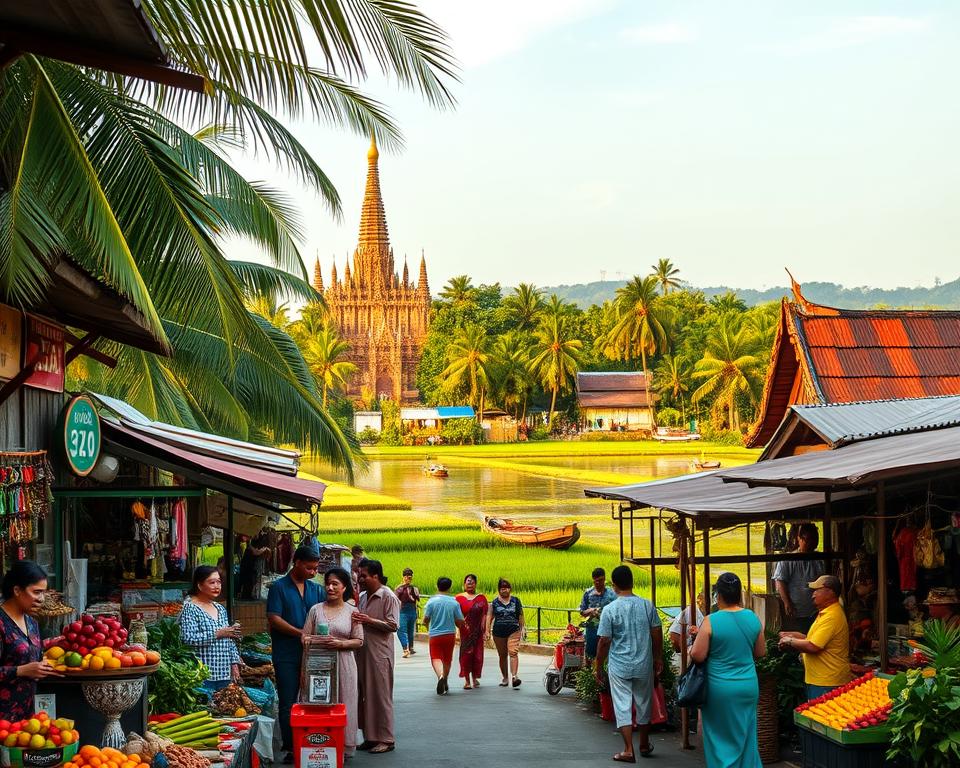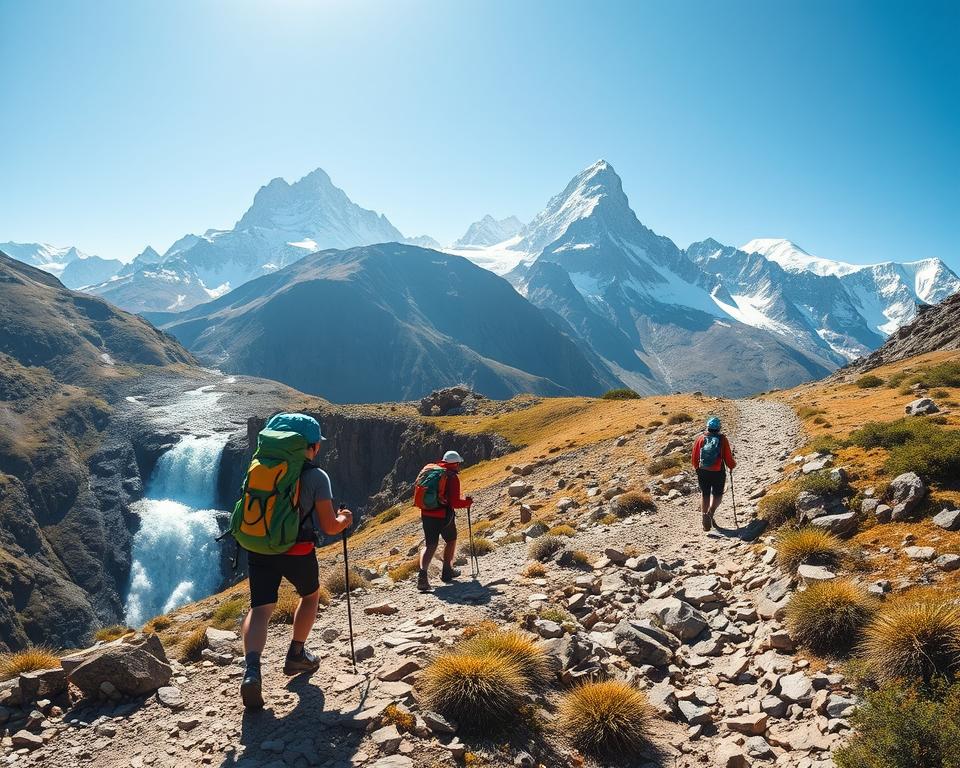Have you ever wondered whether a single tour can change how you see a place—and yourself? This guide shows how well-planned cultural travel can do that without promises of perfection.
You will find practical ways to connect with people and places today, using examples from India’s Golden Triangle, Egypt’s river cruises, and deep-immersion stays such as Benesse House in Naoshima.
The focus is on respectful immersion, clear context, and small-group formats that handle logistics so you can follow your interests. Expert-led visits at sites like Pompeii and Malta’s fortifications turn history into real learning.
Expect realistic ideas for building your own way through cities and countryside—combining festivals, food, and art at a pace that respects local people and place.
Before you book, check official sources and verified operators. Each country and every trip is unique, and this introduction helps you think like a responsible planner for meaningful lifelong adventures that engage your senses.
Introduction: cultural travel experiences that help you learn, connect, and grow
Begin by prioritizing the people, rituals, and daily rhythms that shape a destination. This approach helps you learn without turning a trip into a checklist.
Why this matters today: Communities around the world share traditions through festivals, markets, and museums. New museum programs and community-led initiatives model ethical exchange. Look for hosts who are trained and fairly paid.
How to think about time and place: Season and local routines shape what you can see. Some rituals invite quiet observation. Others welcome guided participation. Build pauses into each day so you can reflect and adapt.
Responsible choices: Choose cultural tours that show where the money goes. Confirm festival dates, museum hours, visa rules, and safety details with official sources before you book.
For tips on mindful planning and wellness-focused immersion, see this guide.
- You’ll focus on people and living traditions, not only monuments.
- You’ll plan around time-sensitive rituals and seasonal events.
- You’ll prioritize tours with clear community benefits and credentials.
Festival immersion: vivid days and nights of music, rituals, and color
Festivals compress history, music, and ritual into a handful of vivid days. They show how people mark a place and invite you to learn by watching and joining with care.
Light and joy: Diwali in India and Loy Krathong in Thailand
In India, Diwali fills cities like Jaipur and Delhi with diyas and fireworks. Respect family customs and ask before photographing people.
In Thailand, Loy Krathong in Chiang Mai centers on rivers and floating lanterns. Use eco-friendly krathong and follow local waste rules to protect waterways.
Movement and meaning: tango evenings in buenos aires
Buenos Aires offers tango shows and milongas in San Telmo and La Boca. Take a beginner class first, learn the cabeceo invitation, and watch before you join.
Practical tips: timing, etiquette, and crowd-wise planning
- Check official city calendars for exact dates—many events shift by lunar time.
- Book centrally located stays to move between festival hubs in busy cities.
- Buy tickets or join a verified cultural tour so you know how to take part.
- Carry cash, dress for local norms, and follow steward guidance to stay safe and respectful.
Heritage sites and living history: from ancient worlds to modern memory
Walking through a ruined villa or a battlefield can reframe what you thought you knew about the past. You learn best when sites combine objects, archives, and local voices to give layers of context.
Specialist programs around the Bay of Naples—Pompeii, Herculaneum, and Oplontis—study daily Roman life and AD 79 events. Join expert-led tours or short archaeological sessions to unpack art, domestic spaces, and trade networks.
Across Europe, guided routes through castles, fortifications in Malta, and curated battlefield visits on the Western Front or in Berlin help you link strategy with human stories. In South Africa, museums such as the Apartheid Museum and Constitution Hill make recent civic memory legible and teach civic lessons about a country’s modern path.
Plan practically: book timed tickets, download official site apps, and expect walking-intensive days. Bring sun protection, water, and comfortable shoes so you can focus on learning, not fatigue.
- Use a knowledgeable guide or audio guide for layers of interpretation.
- Pair major sites with smaller museums to see how art and daily life intersect.
- Allow quiet time after difficult exhibits to reflect on what you saw.
Japan up close: ryokan stays, art-forward cities, and onsen towns
A trip to Japan often balances hush and spectacle — traditional ryokan rest and striking modern art spaces. You can plan multi-city days by rail and mix quiet onsen nights with museum afternoons.
Stay local: sleep in a traditional ryokan and savor kaiseki
Stay one night in a ryokan to learn about tatami rooms, yukata robes, and seasonal kaiseki. This unique cultural experience spotlights regional ingredients and quiet hospitality.
Art in motion: Naoshima, Benesse House, and teamLab
Visit Naoshima for outdoor installations and consider Benesse House if rooms fit your budget; book early. In Tokyo, check official sites for teamLab exhibitions and pair big museums with smaller galleries for richer art days.
Seasonal sense: winter onsen charm and culture-rich city days
Onsen towns such as Kinosaki, Ginzan, Dogo, and Takayama have snowy landscapes that deepen atmosphere. Learn bath etiquette, confirm tattoo policies, and use Japan Rail passes or IC cards to link destinations. Pack light, send a bag ahead with takkyubin, and leave time to wander neighborhood markets and food halls for budget-friendly tastings.
India and the Golden Triangle plus beyond: traditions, taste, and time
From sunrise at the Taj to dusk in a Jaipur bazaar, this region offers layered moments that shape your understanding of place.
Delhi–Agra–Jaipur in 5–7 days lets you see major monuments and practice everyday customs. Plan the Taj Mahal at sunrise and fit Humayun’s Tomb or the Red Fort into a cooler morning. In Jaipur, set aside time for Amber Fort and local bazaars.
Book hands-on cooking with a family host to learn spice layering and regional dishes. Try craft workshops in block printing or miniature painting. Choose a heritage stay in a restored haveli for atmosphere, but read reviews to check service and location trade-offs.
Pace and planning are key. Allow rest during hot afternoons and move some visits to early morning or evening. Check official ticketing for the Taj and confirm ID rules before your trip.
- Short tours: 5–6 days for highlights across Delhi, Agra, and Jaipur.
- Mid-length: 8–10 days to add Mumbai or Ranthambore for wildlife and city contrasts.
- Longer options: 12+ days for Rajasthan countryside, Varanasi rituals, or nearby Nepal extensions.
Mind festival timing—Holi and Diwali dates change annually. If you join, wear protective clothing for Holi and follow local guidance. Look for community-led options that respect tribes and local traditions, and avoid promises of guaranteed outcomes.
Vietnam, Cambodia, and Thailand: culinary life, temples, and river cultures
Southeast Asia’s Mekong delta, bustling markets, and temple courtyards offer a sensory map of food, faith, and daily life. This region mixes street kitchens, river rituals, and world-class monuments over compact distances.
Street food to family kitchens: tasting the region’s history
You’ll plan food-focused days that start at market stalls and end in family kitchen classes. Join guided tours in Hanoi and Ho Chi Minh City to vet vendors and learn safe choices.
Pick busy stalls, watch turnover, and avoid ice in drinks if hygiene seems uncertain. Use a local tour that checks vendors in major cities for peace of mind.
Temples and water rituals: mindful conduct and respectful dress
Time temple visits for early light and cooler hours. Wear covered shoulders and knees, remove shoes where required, and carry small bills for donations.
- Plan 10–22 day packages to balance Angkor Wat, Tonlé Sap, and floating markets without rush.
- Confirm sunrise permits, floating market schedules, and preservation rules like no-drone zones.
- Use regional flights or trains, download offline maps, and ask before photographing monks or elders.

South Africa and Kenya: people, wildlife, and the rhythm of daily life
Southern Africa and Kenya offer city archives and open plains where you learn by listening and by walking with local hosts. Start in urban centers to build context, then move slowly into community-led programs in conservancies and coastal towns.
Johannesburg to Cape Town: Visit the Apartheid Museum and Constitution Hill to ground modern civic history. Walk Bo-Kaap to learn Cape Malay heritage, then spend a day in the winelands for food-and-wine pairing and local craft markets.
Maasai and Samburu exchange: Choose lodges or tours that hire and train local people as guides and hosts. Look for transparent policies on revenue sharing with tribes and craft cooperatives. Confirm that performances are by invitation and that storytelling is paid.
Ethical encounters: Ask how your visit supports education, conservation, or cultural programming. Remember seasonal limits—wildlife and coastal programs depend on weather. Build flexibility into your days and prioritize patience and fair compensation for a richer lifetime memory.
- Start with museums to gain context.
- Pick community-first operators with clear revenue policies.
- Plan for seasonal changes and local safety rules.
Argentina and Peru: music, markets, and mountain traditions
Argentina and Peru pair urban rhythm and mountain craft to offer memorable days of music, food, and history.
Buenos Aires barrios, tango culture, and café society
You’ll map buenos aires by barrios, starting in La Boca for painted streets and tango shows. Walk cobbled lanes, then move to Palermo and Recoleta for café life and small museums.
Plan an evening as a small-group lesson followed by a show so you balance watching and trying the dance yourself. Pick verified tours that keep group sizes low.
Andean highlands: artisan textiles, markets, and coca traditions
Head north to Salta and Jujuy to visit markets where textile cooperatives work with family skills. Buy from named workshops and ask about fair pricing to support local makers.
You’ll taste empanadas salteñas and try coca tea at altitude; follow local guidance and respect how these traditions are used. Learn the history that links indigenous craft with colonial layers before you shop.
Wine valleys and estancias: gaucho life and regional cuisine
Spend days in Mendoza’s wine valleys walking vineyard paths and booking tastings that highlight terroir and climate. Stay at an estancia to learn gaucho life and watch an asado ritual.
Choose slower transfers between places, use regional flights or overnight buses, and pack layers for mountain weather shifts. Review tour outlines to confirm fair-trade visits and transparent sourcing.
“Listen first, ask second, and let local guides shape what you see.”
- You’ll plan flexible days to match market hours and museum seasons.
- You’ll balance city art, mountain markets, and vineyard valleys for a rounded region experience.
- You’ll leave with sharper senses and a new love of local music and food.
New Zealand’s Māori heritage and modern culture
To understand modern New Zealand, trace the threads from historic treaties to present public life. Start where history meets ceremony and language, and let local guides explain the context.
Waitangi Treaty Grounds: context for bicultural Aotearoa
You’ll begin at the Waitangi Treaty Grounds near Paihia to learn how the 1840 Treaty shaped relations between Māori and the Crown in this country. Timed visits and guided talks give clear, updated context without sensationalizing events.
Rotorua encounters: kapa haka, geothermal landscapes, and craft
In Rotorua you’ll attend kapa haka performances and see carving schools at sites like Te Puia and Tamaki Māori Village. Pair performances with walks among geothermal landscapes to read land and legend together.
- Support iwi- and hapū-led offerings that explain pōwhiri protocols and respectful participation.
- Visit Te Papa in Wellington for rotating exhibits that link history and contemporary culture.
- Plan scenic drives or short flights between hubs and book peak times in advance.
Practical note: Choose operators who consult communities, share benefits, and teach basic te reo Māori phrases before you join a tour. Customs differ among tribes—follow host instructions on clothing, photos, and ceremony.
“Listen, ask, and step back when hosts invite you to observe—good visits leave communities stronger.”
Designing your cultural tour: tech, timing, and traveler behavior today
Good tours start with clear questions: who leads, who benefits, and how flexible is the schedule.
Booking smarter: trusted operators, reviews, and guide credentials
Shortlist operators by checking third-party reviews, verifying guide qualifications, and confirming insurance and local licensing. Compare inclusions line by line—group size, guided entries, and free time matter.
Travel tech essentials: translation, offline maps, and museum apps
Download offline maps, install translation apps with packs, and add museum apps that offer audio or AR. Secure timed tickets for high-demand sites so your day avoids long queues and rushed viewing.
Marketing signals to read: authenticity claims vs. real community benefit
Read marketing with a critical eye. Ask how “authentic” experiences are structured, who leads them, and whether partnerships with local organizations are published.
- Confirm tipping, dress codes, and photo rules before your trip.
- Back up documents to encrypted cloud storage and carry paper copies for visas and bookings.
- Plan around weather and festival calendars; the one best option depends on your timing and pace.
“Consult official tourism boards and embassies for entry rules and safety updates.”
Cultural travel experiences: a list of ways to take part around the world
Short, meaningful interactions—like sharing a meal or joining a ceremony—shape how you remember a destination.
Practical ways to join in:
- You’ll take part in tea ceremonies or water blessings with hosts who explain each step, creating a calm, thoughtful experience.
- You’ll sleep in houses that keep culture close—trulli in Puglia, ryokans in Japan, or restored heritage hotels in India—book early for peak days.
- You’ll plan city walking tours to meet local guides, learn neighborhood stories, and save days for cafes, markets, and public art.
- You’ll consider rural homestays in the Andes or Southeast Asia to learn recipes, farming rhythms, and crafts while confirming how your visit supports the family.
- You’ll add a day in the South African winelands for terroir-driven tastings and food pairings that showcase regional producers.
Include Māori visits in New Zealand to learn protocols and basic language that deepen your understanding. Balance guided tours with free time so you can return to places you love.
Practical note: Availability and rules vary—confirm details with official sources and licensed operators before you book.
Conclusion
Finish planning with the idea that one quiet afternoon can teach you as much as a full museum day.
You’ll shape a cultural tour around what matters to you and the people you meet. Pick hosts and partners who share benefits fairly, from South Africa to New Zealand.
Allow time to listen, taste, and observe. Verify visas, closures, and safety updates with official sources before your trip.
Use tech for maps and translation, but leave space for offline talks that bring life to a destination. Expect no one best path—each country and day will be different.
Travel with humility, ask permission before photos, and come home with stories that deepen your understanding of the world and your life today.


